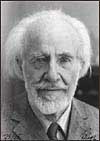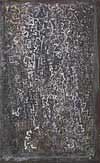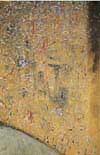"Mine are the Orient, the Occident, science, religion, cities, space, and writing a picture": A Retrospective Exhibition
Artwork by: Mark Tobey
Location: Museo Nacional Centro de Arte Reina Sofía
11 November 1997 to 12 January 1998, Madrid, Spain
Review by: Brad Pokorny

Mark Tobey in 1971
click to see larger photo
“Migrating from continent to continent like a restless bird in
search of propitious seasons, casting his glance across all cultures, Mark Tobey was
one of the few 20th century artists who was truly cosmopolitan and in fact trans-avant-garde.”
- Kosme de Barañano, co-curator,
Tobey restrospective

White Writing
by Mark Tobey
click to see larger photo
"Many artists have used such 'pictography'
to express themselves, such as Miró, Klee or others. But
Tobey had that unique advantage of knowing the mystical value
of the calligraphy. Mark Tobey was conscious that he was creating
mystical art."
- Ferran Roca Bon, contemporary Spanish
Bahá'í painter

Painting by Mark Tobey
click to see larger photo

click to see larger photo
|
Except perhaps for the Founders of the world's great
religions, no one on this earthly plane can be said to fully understand
the nature and composition of the spiritual world. But that has
certainly not stopped people from trying to communicate their
visions of it.
Such attempts can be found in the stained glass windows
of Europe's great cathedrals, in the complex filigree of Persian
prayer rugs, or in the meditative tones of Buddhist chants - to
mention just a few such humble expressions of spiritual reality
made throughout history.
But what is the modern equivalent? Where might we
turn to find a new vision of spiritual expression - one capable
of inspiring deep feelings - in our modern, technological and
secular age? And are there any who have also captured the contemporary
climate of cross-culturalism, interdependence and oneness that
surely characterizes the highest expression of spiritual values
today?
There are certainly many artists, musicians and architects
who are seeking to realize such a vision. One individual whose
work would certainly be a starting point in such a survey is the
American painter Mark Tobey.
Tobey, who was born in Wisconsin, USA, in 1890 and
died in 1976 in Switzerland, has gained increasing recognition
in recent years - an appreciation that has perhaps reached its
highest point yet in a superlative retrospective exhibition at
Spain's prestigious Museo Nacional Centro de Arte Reina Sofía,
held from 11 November 1997 to 12 January 1998.
The exhibition brought together about 130 works from
some 56 different collections, covering the years from 1924 to
1975 - virtually the entire creative period of Tobey's long and
productive life. The exhibition included works in oil, watercolor,
charcoal and tempera, and it sought, in the words of the catalogue,
to "explore Mark Tobey's complex pictorial world, emphasizing
its most transcendent aspects."
The curators succeeded in their goal. The exhibition
not only showcased the great range and diversity of Tobey's work
but also captured and conveyed the deeply emotional - and, we
must add, "spiritual" - content of his vision.
Tobey is of course most famous for his creation of
so-called "white writing" - an overlay of white or
light-colored calligraphic symbols on an abstract field which
is often itself composed of thousands of small and interwoven
brush strokes. And this method, in turn, gave rise to the type
of "all-over" painting style made most famous by Jackson
Pollock, another American painter to whom Tobey is often compared.
(A new essay by Judith S. Kays, published in the exhibition's
catalogue, establishes to a high degree of certainty that Pollock
was familiar with Tobey, and quite likely influenced by him, before
Pollock himself began working in the all-over style - something
that art historians had previously overlooked.)
The exhibition in Madrid provided many fine examples
of both the white-writing and all-over styles, from Broadway Norm
(1935) to later works such as White Writing (1951), Shadow Spirits
of the Forest (1961), and River Fog (1970).
A careful examination of the works gathered in Madrid
also tell much about Tobey's attempt to express his vision of
spiritual reality. On the surface, this aspect of Tobey's intention
can be understood simply from the titles of many of his paintings:
Saints and Serpents (1953); Meditative Series I (1954); Fragments
in Time and Space (1956); Prophetic Night (1956); Mysterious Light
(1958); and Prophetic Light Dawn (1958).
But even where the titles do not indicate a specifically
spiritual theme, the luminosity, complexity and, indeed, ethereal
nature of the paintings often combine to transport the viewer
to a wholly different place.
Take, for example, New Crescent (1953). At first
glance, this tempera painting done predominantly in yellow-greens
and white over a dark field appears to be a rather flat and monotonous
abstraction in the all-over style. Yet careful study shows the
work to be multi-layered, and with many regions of lambent radiance
and lustrous depth. It might be best described as shimmering with
the colors of moonlight. After a time, viewers can easily find
themselves being pulled into another dimension.
Beyond such traditional or mystical elements of spirituality,
there is also a way in which the titles and the paintings themselves
work in concert to express new spiritual ideas for this age.
Take Red Man, White Man, Black Man (1945) which,
given Tobey's religious beliefs, must surely be understood in
part as an expression of the oneness of humanity. Almost entirely
abstract, with the calligraphic features of white writing, it
also appears to create an interconnected web or network uniting
the barely perceptible human figures that populate some regions
of the canvas.
Or consider the four paintings presented in the exhibition
from the Above the Earth series, created between 1953 and 1956,
which each depict a portion of a circle in space (presumably the
Earth). They seem prophetic of the famous photographs that would
be taken, a decade and a half later, by astronauts and which show
the Earth in all its oneness.
Such themes are Bahá'í and Tobey was,
as is well known, an active Bahá'í from his acceptance
of the Faith in 1918 until his death. Art critics and historians
of various backgrounds have agreed that Tobey was enormously influenced
by his religious beliefs and that he sought to express elements
of them in his paintings.
"Bahá'í provided Tobey with aesthetic
as well as social and religious principles," wrote William
C. Seitz, curator of Painting and Sculpture Exhibitions at the
Museum of Modern Art in New York, at the time of the Museum's
1962-63 exhibition of Tobey's work. "He has often stated
that there can be no break between nature, art, science, religion,
and personal life… Few religions…have given the concept
of oneness such pointed emphasis, and few modern artists have
dealt with it as explicitly as has Tobey."
The significance of his Faith in relation to his
art is something that Tobey himself acknowledged on many occasions.
"The root of all religions, from the Bahá'í
point of view, is based on the theory that man will gradually
come to understand the unity of the world and the oneness of mankind,"
Tobey wrote in 1934. "It teaches that all the prophets are
one - that science and religion are the two great powers which
must be balanced if man is to become mature. I feel my work has
been influenced by these beliefs. I've tried to decentralize and
interpenetrate so that all parts of a painting are of related
value... Mine are the Orient, the Occident, science, religion,
cities, space, and writing a picture."
In his life, as well, Tobey lived as a world citizen,
eschewing any notion that he was an "American" painter.
He spent his early years in the American Midwest, and then began
working intermittently in New York in 1913. He first moved to
Seattle, in the American Northwest, in 1923. He also made several
trips to Europe and the Middle East in the 1920s and he lived
for a time in England. In 1934, he went to China and Japan, where
he stayed for a number of months in a Zen monastery near Kyoto.
After World War II, he continued to live and work in Seattle,
but in 1960 he moved to Basel, Switzerland.
Kosme de Barañano, one of the curators of
the exhibition, characterizes him this way: "Migrating from
continent to continent like a restless bird in search of propitious
seasons, casting his glance across all cultures, Mark Tobey was
one of the few 20th century artists who was truly cosmopolitan
and in fact trans-avante-garde. Besides being a pioneer of American
abstraction, he was a scholar of oriental calligraphy and Renaissance
tempera."
Ferran Roca Bon, a contemporary painter in Barcelona
who is also a Bahá'í, spoke about Tobey in a recent
interview. "He was a very sensitive person, self-educated,
cosmopolitan, spiritual," said Mr. Roca Bon. "He opened
himself to spirituality and discovered the sensibility and refinement
of the Orient, and thanks to the Bahá'í Faith, he
discovered the 'magic' of calligraphy.
Mr. Roca Bon said he believes that, in fact, Tobey's
white writing was inspired by the style of Arabic calligraphy
which is manifest in original letters and tablets from Bahá'u'lláh,
the Founder of the Bahá'í Faith, whose fast-flowing
revelation was often transcribed quite rapidly by special secretaries,
creating something like an an all-over composition in its initial
form.
"Many artists have used such 'pictography' to
express themselves, such as Miró, Klee or others,"
said Mr. Bon. "But Tobey had that unique advantage of knowing
the mystical value of the calligraphy. Mark Tobey was conscious
that he was creating mystical art."
Tobey won international acclaim for his work towards
the end of his life. He became the first American since James
Abbot Whistler (1834-1903) to win the Painting Prize at the Venice
Biennale, an award he won in 1959. In 1961, he had a retrospective
showing at the Louvre in Paris, an extraordinary tribute to the
work of a living artist. These landmark achievements were followed
by a major exhibition at the New York Museum of Modern Art in
1962 and, in 1974, another major show at the National Collection
of Fine Arts in Washington, which is part of the Smithsonian Institution.
Art critics and historians in the United States have
long been uncertain exactly how to categorize Tobey. Many gave
Pollock most of the credit for creating the all-over style. Others
have suggested that Tobey's internationalism and even his religion
have so far kept him from being accepted in mainstream art circles.
The Madrid exhibition and its outstanding catalogue,
one can hope, will set this sense of underappreciation aright.
For certainly it revealed that Tobey, while defying categorization,
must be counted as one of the 20th Century's most innovative and,
ultimately, influential artists.
|
|
